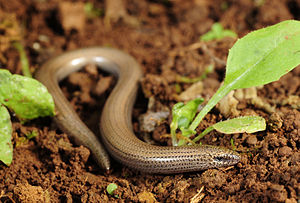Mottled snake skink
| Mottled snake skink | ||||||||||||
|---|---|---|---|---|---|---|---|---|---|---|---|---|

Mottled snake skink |
||||||||||||
| Systematics | ||||||||||||
|
||||||||||||
| Scientific name | ||||||||||||
| Ophiomorus punctatissimus | ||||||||||||
| ( Bibron & Bory , 1833) |
The speckled snake skink ( Ophiomorus punctatissimus ) is a species of reptile belonging to the skink family . There are no known subspecies .
features
Small, smooth, scaly skink with an elongated, serpentine, legless body. With a head-trunk length of up to 10 cm, it reaches a total length of about 20 cm. The small, pointed, slightly angular-looking head has a rounded snout , small eyes and barely discernible ear openings covered by scales . The round tail ends in a cone. The basic color is yellowish, cream-colored or light brownish. The sides and belly can be flesh-colored. The scales each have a dark point. These points, which are arranged in longitudinal rows, are less developed on the back than on the flanks, abdomen and tail. The sexes differ mainly in the female's tail clearly separated from the trunk. Young animals are light slate gray to cream-colored, the dark points flow together to form longitudinal bands.
Way of life
Little is known about the biology of this skink. In general, he probably leads an underground way of life. In terrariums, supernatural activity has also been observed in the early morning. The specimens observed so far in the coastal lowlands were all discovered in spring during the morning hours and always under stones. Individuals were found here as early as January. In the coastal lowlands the snake skink retreats completely deeper into the ground in midsummer. It is questionable whether he will remain active there or take a summer break. In Feneos , the speckled snake skink was detected at altitudes between 740 and 780 m above sea level from April to October. Most of the animals were found in May and June. At these altitudes, hibernation is held from November to February or March. The fact that the species can mainly be found under stones during the day suggests that they are looking for contact to warm up.
The mating season is believed to be in April / May. From terrarium reports only reproduction by oviparity (laying eggs) is known. After a gestation of 3 months, a clutch of 2 to 4 eggs is laid just below the surface of the earth (especially under stones) between July and August. These are elongated, 15 mm long and 7 mm wide. Its parchment-like shell is whitish.
The prey spectrum includes various insects and arachnids . Nothing is known about the biocenosis regarding predators .
distribution
Eastern and south-eastern central Greece, the Attica area and the Peloponnese as well as small islands near Githion and the island of Kythira . In the case of populations in southwestern Anatolia, the species affiliation has not been clarified without a doubt, it may be a separate species. The speckled snake skink penetrates at heights of up to about 800 m above sea level.
habitat
The Speckled Snake Skink prefers sunny, quite warm and dry areas and often lives on clayey soils covered with sparse grass and shrub vegetation, with sloping slopes apparently remaining uninhabited. Light coastal dune forests and biotopes of a similar structure are also inhabited.
Danger
Little is known about the current population, but the Greek populations are considered stable and not endangered. In Feneos, an average of 10 to 20 individuals were found on 100 m². Intensive agricultural use of the soil (lack of stones and rocks, pesticide pollution, heavy cultivation, etc.), general loss of biotopes through development and forest fires represent dangers for the speckled snake skin. Sensible protective measures are the designation of protected areas and extensive agriculture .
literature
- Dieter Glandt: Pocket dictionary of amphibians and reptiles in Europe. All types from the Canary Islands to the Urals . Quelle and Meyer, Wiebelsheim 2010, ISBN 3494014701 .
- Josef H. Reichholf & Gunter Steinbach: Nature Encyclopedia of Europe / Volume 1 , Vierfüsser (mammals, amphibians, crawfish), Mosaik Verlag 1992, ISBN 3-576-10101-2 .
Web links
- Among researchers (PDF file; 498 kB)
- Ophiomorus punctatissimus in The Reptile Database
- Research at the Anhalt University of Applied Sciences in Greece
- Ophiomorus punctatissimus inthe IUCN Red List of Threatened Species 2013.1. Posted by: Petros Lymberakis, Varol Tok, Ismail H. Ugurtas, Murat Sevinç, Pierre-André Crochet, Yakup Kaska, Yusuf Kumlutaş, Uğur Kaya, Aziz Avci, Nazan Üzüm, Can Yeniyurt, Ferdi Akarsu, 2008. Accessed November 1 2013.
